6-orthoplex
| 6-orthoplex Hexacross | |
|---|---|
 Orthogonal projection inside Petrie polygon | |
| Type | Regular 6-polytope |
| Family | orthoplex |
| Schläfli symbols | {3,3,3,3,4} {3,3,3,31,1} |
| Coxeter-Dynkin diagrams | |
| 5-faces | 64 {34} |
| 4-faces | 192 {33} |
| Cells | 240 {3,3} |
| Faces | 160 {3} |
| Edges | 60 |
| Vertices | 12 |
| Vertex figure | 5-orthoplex |
| Petrie polygon | dodecagon |
| Coxeter groups | B6, [3,3,3,3,4] D6, [33,1,1] |
| Dual | 6-cube |
| Properties | convex |
In geometry, a 6-orthoplex, or 6-cross polytope, is a regular 6-polytope with 12 vertices, 60 edges, 160 triangle faces, 240 tetrahedron cells, 192 5-cell 4-faces, and 64 5-faces.
It has two constructed forms, the first being regular with Schläfli symbol {34,4}, and the second with alternately labeled (checkerboarded) facets, with Schläfli symbol {3,3,3,31,1} or Coxeter symbol 311.
It is a part of an infinite family of polytopes, called cross-polytopes or orthoplexes. The dual polytope is the 6-hypercube, or hexeract.
Alternate names
- Hexacross, derived from combining the family name cross polytope with hex for six (dimensions) in Greek.
- Hexacontitetrapeton as a 64-facetted 6-polytope.
Construction
There are three Coxeter groups associated with the 6-orthoplex, one regular, dual of the hexeract with the C6 or [4,3,3,3,3] Coxeter group, and a half symmetry with two copies of 5-simplex facets, alternating, with the D6 or [33,1,1] Coxeter group. A lowest symmetry construction is based on a dual of a 6-orthotope, called a 6-fusil.
| Name | Coxeter diagram | Schläfli symbol | Symmetry | Order | Vertex figure |
|---|---|---|---|---|---|
| Alternate 6-orthoplex | {3,3,3,3,4} | [3,3,3,3,4] | 46080 | ||
| regular 6-orthoplex | {3,3,3,31,1} | [3,3,3,31,1] | 23040 | ||
| 6-fusil | 6{} | [25] | 64 |
Cartesian coordinates
Cartesian coordinates for the vertices of a 6-orthoplex, centered at the origin are
- (±1,0,0,0,0,0), (0,±1,0,0,0,0), (0,0,±1,0,0,0), (0,0,0,±1,0,0), (0,0,0,0,±1,0), (0,0,0,0,0,±1)
Every vertex pair is connected by an edge, except opposites.
Images
| Coxeter plane | B6 | B5 | B4 |
|---|---|---|---|
| Graph |  |
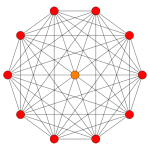 |
 |
| Dihedral symmetry | [12] | [10] | [8] |
| Coxeter plane | B3 | B2 | |
| Graph |  |
 | |
| Dihedral symmetry | [6] | [4] | |
| Coxeter plane | A5 | A3 | |
| Graph |  |
 | |
| Dihedral symmetry | [6] | [4] |
Related polytopes
The 6-orthoplex can be projected down to 3-dimensions into the vertices of a regular icosahedron, as seen in this 2D projection:
 Icosahedron H3 Coxeter plane |
 6-orthoplex D6 Coxeter plane |
| This construction can be geometrically seen as the 12 vertices of the 6-orthoplex projected to 3 dimensions. This represents a geometric folding of the D6 to H3 Coxeter groups: Seen by these 2D Coxeter plane orthogonal projections, the two overlapping central vertices define the third axis in this mapping. | |
It is in a dimensional series of uniform polytopes and honeycombs, expressed by Coxeter as 3k1 series. (A degenerate 4-dimensional case exists as 3-sphere tiling, a tetrahedral hosohedron.)
| Space | Finite | Euclidean | Hyperbolic | |||
|---|---|---|---|---|---|---|
| n | 4 | 5 | 6 | 7 | 8 | 9 |
| Coxeter group |
A3A1 | A5 | D6 | E7 |  =E7+ =E7+ |
 =E7++ =E7++ |
| Coxeter diagram |
||||||
| Symmetry | [3−1,3,1] | [30,3,1] | [[3<sup>1,3,1</sup>]] | [32,3,1] | [33,3,1] | [34,3,1] |
| Order | 48 | 720 | 46,080 | 2,903,040 | ∞ | |
| Graph |  |
 |
 |
- | - | |
| Name | 31,-1 | 310 | 311 | 321 | 331 | 341 |
This polytope is one of 63 uniform 6-polytopes generated from the B6 Coxeter plane, including the regular 6-cube or 6-orthoplex.
 β6 |
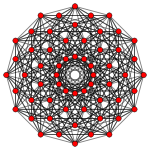 t1β6 |
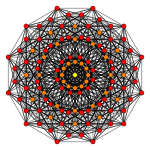 t2β6 |
 t2γ6 |
 t1γ6 |
 γ6 |
 t0,1β6 |
 t0,2β6 |
 t1,2β6 |
 t0,3β6 |
 t1,3β6 |
 t2,3γ6 |
 t0,4β6 |
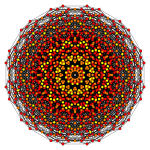 t1,4γ6 |
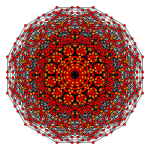 t1,3γ6 |
 t1,2γ6 |
 t0,5γ6 |
 t0,4γ6 |
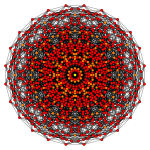 t0,3γ6 |
 t0,2γ6 |
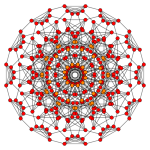 t0,1γ6 |
 t0,1,2β6 |
 t0,1,3β6 |
 t0,2,3β6 |
 t1,2,3β6 |
 t0,1,4β6 |
 t0,2,4β6 |
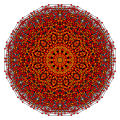 t1,2,4β6 |
 t0,3,4β6 |
 t1,2,4γ6 |
 t1,2,3γ6 |
 t0,1,5β6 |
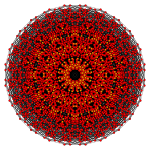 t0,2,5β6 |
 t0,3,4γ6 |
 t0,2,5γ6 |
 t0,2,4γ6 |
 t0,2,3γ6 |
 t0,1,5γ6 |
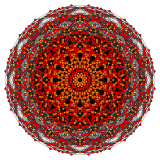 t0,1,4γ6 |
 t0,1,3γ6 |
 t0,1,2γ6 |
 t0,1,2,3β6 |
 t0,1,2,4β6 |
 t0,1,3,4β6 |
 t0,2,3,4β6 |
 t1,2,3,4γ6 |
 t0,1,2,5β6 |
 t0,1,3,5β6 |
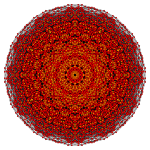 t0,2,3,5γ6 |
 t0,2,3,4γ6 |
 t0,1,4,5γ6 |
 t0,1,3,5γ6 |
 t0,1,3,4γ6 |
 t0,1,2,5γ6 |
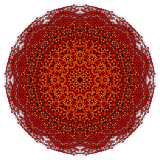 t0,1,2,4γ6 |
 t0,1,2,3γ6 |
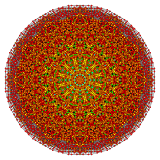 t0,1,2,3,4β6 |
 t0,1,2,3,5β6 |
 t0,1,2,4,5β6 |
 t0,1,2,4,5γ6 |
 t0,1,2,3,5γ6 |
 t0,1,2,3,4γ6 |
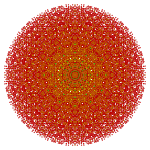 t0,1,2,3,4,5γ6 |
References
- H.S.M. Coxeter:
- H.S.M. Coxeter, Regular Polytopes, 3rd Edition, Dover New York, 1973
- Kaleidoscopes: Selected Writings of H.S.M. Coxeter, edited by F. Arthur Sherk, Peter McMullen, Anthony C. Thompson, Asia Ivic Weiss, Wiley-Interscience Publication, 1995, ISBN 978-0-471-01003-6
- (Paper 22) H.S.M. Coxeter, Regular and Semi Regular Polytopes I, [Math. Zeit. 46 (1940) 380-407, MR 2,10]
- (Paper 23) H.S.M. Coxeter, Regular and Semi-Regular Polytopes II, [Math. Zeit. 188 (1985) 559-591]
- (Paper 24) H.S.M. Coxeter, Regular and Semi-Regular Polytopes III, [Math. Zeit. 200 (1988) 3-45]
- Norman Johnson Uniform Polytopes, Manuscript (1991)
- N.W. Johnson: The Theory of Uniform Polytopes and Honeycombs, Ph.D. 1966
- Richard Klitzing, 6D uniform polytopes (polypeta), x3o3o3o3o4o - gee
External links
- Olshevsky, George, Cross polytope at Glossary for Hyperspace.
- Polytopes of Various Dimensions
- Multi-dimensional Glossary
| Fundamental convex regular and uniform polytopes in dimensions 2–10 | ||||||||||||
|---|---|---|---|---|---|---|---|---|---|---|---|---|
| Family | An | Bn | I2(p) / Dn | E6 / E7 / E8 / F4 / G2 | Hn | |||||||
| Regular polygon | Triangle | Square | p-gon | Hexagon | Pentagon | |||||||
| Uniform polyhedron | Tetrahedron | Octahedron • Cube | Demicube | Dodecahedron • Icosahedron | ||||||||
| Uniform 4-polytope | 5-cell | 16-cell • Tesseract | Demitesseract | 24-cell | 120-cell • 600-cell | |||||||
| Uniform 5-polytope | 5-simplex | 5-orthoplex • 5-cube | 5-demicube | |||||||||
| Uniform 6-polytope | 6-simplex | 6-orthoplex • 6-cube | 6-demicube | 122 • 221 | ||||||||
| Uniform 7-polytope | 7-simplex | 7-orthoplex • 7-cube | 7-demicube | 132 • 231 • 321 | ||||||||
| Uniform 8-polytope | 8-simplex | 8-orthoplex • 8-cube | 8-demicube | 142 • 241 • 421 | ||||||||
| Uniform 9-polytope | 9-simplex | 9-orthoplex • 9-cube | 9-demicube | |||||||||
| Uniform 10-polytope | 10-simplex | 10-orthoplex • 10-cube | 10-demicube | |||||||||
| Uniform n-polytope | n-simplex | n-orthoplex • n-cube | n-demicube | 1k2 • 2k1 • k21 | n-pentagonal polytope | |||||||
| Topics: Polytope families • Regular polytope • List of regular polytopes | ||||||||||||